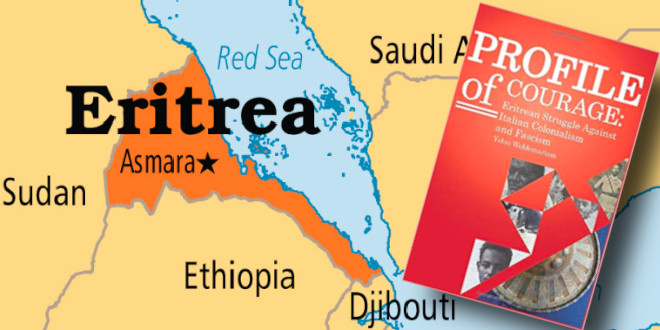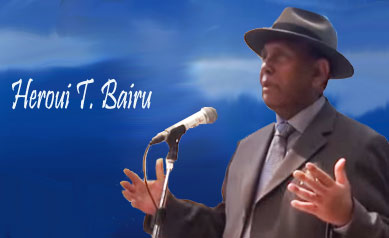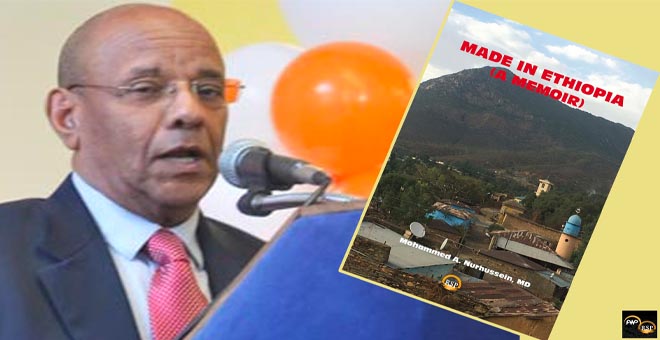SmeTr Hamassien: Objective and Struggle

Book Review by Semere T Habtemariam
Title: SmeTr Hamassien: Objective and Struggle (ስመጥር ሓማሴን፥ ዕላማን ተጋድሎን።)
Author: Dr. Yebio Woldemariam
Language: Tigrinya (146 pages)
Publisher: Ultimate Printing Press
Year: 2017 (2010 Geez Calendar)
The English version is out under the title: Profile of Courage: Eritrean Struggle against Italian Colonization and Fascism.
The author of SmeTr Hammasien (ስመጥር ሓማሴን፥ ዕላማን ተጋድሎን።) grew up listening to his own mother lamenting the indignities her family had endured as the first and early victims of Italian colonialism. She would often say, “May God pluck out the eyes of the Italians.”
But how was Italy, a country that was itself not unified till 1861 and considered second-rate by European standards, able to conqueror Eritrea, the ancient and only gateway to Greater Abbyssinia, or Adi Habesha as the author puts it? What were the socio-political and economic factors that contributed to the subjugation of the people of the Horn of Africa in general and Eritreans in particular under Italian rule?
An attempt to answer these questions have led the author to focus on the SmeTr Hammassien: Eritreans who rebelled against Italian colonization by siding with Ethiopia in the aftermath of 1890, when Eritrea was officially declared an Italian African Colony. SmeTr is the Amharic word to signify the heroic deeds of Eritreans (Hamassien) in the service of Ethiopia. Although, it is clear that all the Eritrean SmeTr have one thing in common–hatred of Italian colonization–it is not equally clear that they have a parallel love for Ethiopia.
For some, Ethiopia was a safe haven from political persecution, and for others, it was a land of opportunity where they could easily excel due to their exposure to a much more developed economy in Italian Eritrea, and for some others, it was the mother-land where the prodigal children have to go to, and for some others, it was the cruel reminder of the barbarity inflicted on Eritrean POWs at the orders of Emperor Menelik after the 1896 battle of Adwa.
Personal and selfish self-interest and self-promotion, primordial and atavistic connection, and ideological enlightenment and political alignment and expediency against colonization were all at play. It is more likely the confluence of all factors that led to the rise of the phenomena of SmeTr and reducing it to one factor would render it insufficient as an explanatory and descriptive method. Signalling one reason at the expense of others would neither be true nor helpful in shedding light and help us come to terms with the past. Unlike what the author has said or failed to say, some notable SmeTr have also regretted their role in handing Eritrea to King Haileselassie in silver platter. Asfeha Weldemichael, for instance, did not die waiving the Andnet flag as cited in the book. Before writing this review, I took it upon myself to interview some of his close family members and they all assured me that he died a happy man that Eritrea has won its independence. Ghirmai Haile, a son of SmeTr himself and veteran Tegadalay of the EPLF, has attributed some prophetic words to Asfeha Woldemichael. Apparently Asfeha was not happy with the short-lived alliance between the EPLF and the TPLF and was convinced that Eritreans would soon be rudely awakened by the treacherous nature of Tigrayans. With the outbreak of the 1998-2000, it didn’t take long for Eritreans to resuscitate the old song “of never trust a Tigrayan.” Many Eritreans today, who are familiar with Asfeha’s prophecy, believe that history has proven him right; I am not one of them. Culture and values are not immutable and they change from one generation to the next.
The author makes it clear that Eritreans had benefited hugely from the massive investments colonial Italy had made in Eritrea, so much so, that so many Ethiopians immigrated to and settled in Eritrea to take advantage of these economic opportunities. Eritreans had forfeited normalcy during the zemene cheqatat and DeguA’s (Tigray) rule, and some have even went as far as adopting Islam and Catholicism to protect themselves against the atrocities of succesive Ethiopian war lords. There is a common saying in Eritrea that encapsulated the security, law and order, that Italy brought to Eritrea:
ሽፍትነት ሃጸይ ዮሃንስ ሓሙሽተ ነፍሒ ሒዝካ ንበረኻ፡
ሽፍትነት ጥልያን ይግባይ ኢልካ ናብ ገዛኻ።
All it took for rebellion/banditry to happen during the reign of Emperor Yohannes is to take five rifles (with you) and go to the jungle;
While all it took for rebellion/banditry to end during the reign of Italy is to plead for mercy and return home.
There is no one single and linear narrative to describe the SmeTr Hamassien in Ethiopia. Some SmeTr were actually disappointed by the archaic and oppressive feudal system that kept Ethiopians in chains and darkness. This poignant observation made them strongly feel that Ethiopia would be the poster child of what was wrong with independence if it failed to immediately and completely overhaul its old and defunct system. The most pioneering and radical thinkers in this line of thinking were Blata Ghebrezgabier Gilamariam from Hamasien and Tesfamichael Tikue from Akeleguzay. Even Lorenzo Taazaz, the loadstar of SmeTrism, was not immune to this line of thinking, but above all, didn’t believe that the small but regal Haileselassie was up to the challenge of nation-building: he was not progressive enough.
With all the opportunities that Ethiopia afforded Eritreans, one could easily detect an air of ambivalence in all of them. Their animus toward colonization and their lofty aspiration for independence and freedom could not easily be reconciled with the anachronistic and oppressive feudal system. Ethiopia was the backwater of stagnation and backwardness. They must have felt that they went from the frying pan into the fire. “Ethiopia in its present situation,” Blata Ghebrezgabier Gilamariam accurately predicted, “would easily fall prey to the European hyena.”
The exploitative land tenure that kept Ethiopian peasants in abject poverty and the intra-rivalry of feudal lords that divided the populace into almost semi-autonomous chieftains was inimical to the much-hoped and desired progress and modernity and the defense of the only independent country in Africa against a European colonization. This is, even in light of the fact that the once king of Shewa and Oromo (in the spirit of PC), Emperor Menelik, was the only one who succeeded in bringing modern Ethiopia together after the death of the Tigrayan Emperor of Ethiopia Yohannes. So much for the 3000 continuous and unbroken history of a Solomonic dynasty.
The lack of a unified identity looms large as the be-all-and-end-all explanation of why the people easily fell prey to the Italian conquest in this book, but this does not explain why the same people were able to successfully foil the Egptian invasion in 1875 in Gundet and 1876 in Gura, or why the people of Lowland Eritrea rallied on the side of Ras Alula to defeat the Mahdists in Eritrea in the battle of Kufit in 1885, or why the forces of Ras Alula defeated the advancing Italian forces in the battle of Dogali in 1887. Most importantly Ethiopians won the battle of Adwa, earning themselves the proud distinction of being one of two non-European countries who fought and won a war against a European power. Japan being the second.
Although the author goes to great pains to document his evidence and cite his sources, he does make some general conclusions, however, intuitively right they might seem, that do not pass some serious scrutiny. The good thing of the scientific pursuit is to find a hole in the theory and the whole house of cards comes crumbling down. He does, however, make up for it through his meticulous adherence to facts and there is a lot that he was able to bring to the surface. One could easily learn a lot from this small book packed with primary and secondary sources. The chapter on Zerai Deres was the most illuminating for me; it answered some of the questions I have been raising throughout my life. In this regard, his book is a great addition to the mushrooming literature of Eritrean and Ethiopian studies which is compelling us to litigate the past.
In the prevailing period of uncertainty and perplexity, where our liberators have turned into our tormentors and where a modern and independent Eritrea has become indistinguishable from the old Ethiopia that some SmeTr Hammassien had rightfully decried, one is bound to engage in the examination of the present by unravelling the past. No doubt, the group that comes with the best narrative will win the day. It is the power of storytelling that all religions, civilizations and national mythologies are made of. Ultimately, in the words of George Orowell, “Whoever controls the past will control the future.” History is where some of the most important intellectual battles of the present are fought and it matters a great deal which narrative will eventually prevail. This is not just an academic exercise; a lot is at stake. One of my favorite Veteran Tegadelti is Mohammed Berhan Blatta (Wedi Blatta), who has repeatedly argued that the misguided revisionism of history is futile because the history of modern Eritrea and its national identity is written by the blood of Eritrean patriots–reflecting its mosaic of rich diversity. I like to believe that he is right but it still behooves us to, at least, sleep with one eye open.
The obvious question among many readers would be: Why did the author focus on the SmeTr of Hamassien and use Hamassien instead of Eritrea? And why did he not start with the SmeTr of Ethiopia, or more aptly Jeganu deqi ArbeAa? Don’t we, Eritreans, have many Eritreans of Ethiopian origin, who have proven to be loyal and stalwart advocates of Eritrean independence and many have duly paid the ultimate price for its liberation? This is the story many Eritreans would have liked to first read about. These Eritreans of Ethiopian origin, the Jeganu deqi ArbeAa, deserve more honor and recognition than the SmeTr hamasien. From Weldeab Woldemariam, to Isaias Afwerki and Hagos Kisha, it is the story that is begging to be told. (The latter two should be praised for their role in the liberation of Eritrea and condemned for being the cause of the current misery and dehumanization of the Eritrean people.)
In the competing and often-times contradictory national narratives of both Eritrea and Ethiopia whose side does this book portend to support? The author, in person and in writing, is an intelligent and refined individual and I had the privilege of interacting with him numerous times in my capacity as an activist. He is somebody who does not waver in his stand and is willing to stand alone, if need be, but he would never throw you an arrow before dipping it in honey, and that makes him a double edge sword. In intelligence and profundity and line of thinking, he is in the same class as Tekeste Negash but he is more in tune with social norms of decency and sensitivity than him. He is someone who can disagree with anyone without being disagreeable and that theme is also evident in his book. It is very hard to not respect the two gentlemen; they do their due diligence and always make their due contribution to enhancing our fund of knowledge and understanding. One could hate their politics and appreciate their scholarly contribution. What made this book particularly enjoyable was the authentic and traditional use of the Tigrinya language. His mastery of the Tigrinya language and its impeccable use was the icing on the cake.
Unlike the bright but long-winded Yosief Ghebrehiwet and the crude and shallow Rezene Habte, Yebio is not interested in undoing what has been achieved by the heroic sacrifice of the Eritrean people. Unlike the cacophony of few but loud Ethiopillias and neo-Andnets, his Andnetism operates within the boundaries of reason, decency and knows its limitations. (I stand to be corrected if my reading of his softer version of andnetism is wrong.)
As a student who values knowledge for the sake of knowledge, discourse for the sake of discourse, I can tolerate anything that operates under the rubric of Eritrea and for that, I am obligated to remain open-minded and open-minded I shall remain.
As Eritreans and human beings, we are duty-bound to promote unity on all fundamentals (Eritrean foundational values), liberty on particulars and charity on everything else. The aynfelale and Ertra nErtrawyan credo is what makes Eritrea indivisible. The story of Eritrea is that of national unity, the pursuit of self-rule and self-determination and the struggle continues. In the words of Samora Machel, “A luta continua!” or as my friend, Saleh Gadi Johar would say, “ሕጂ ‘ውን ክውግሕ ‘ዩ። ተማሒርኩም ኣለኹም።”
Profile of Courage: Eritrean Struggle against Italian Colonization and Fascism can be purchased from Amazon: Profiles of Courage
Semere Tesfamicael Habtemariam is the author of Reflections on the History of the Tewahdo Orthodox Church History of Tewahdo Church and Hearts Like Birds Hearts like Birds. He can be reached at his email: weriz@yahoo.com




Awate Forum